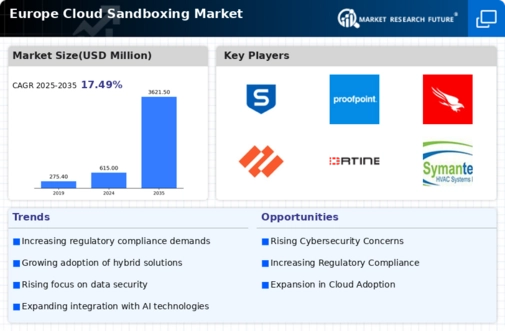Germany : Strong Growth Driven by Innovation
Key cities like Berlin, Munich, and Frankfurt are pivotal in the cloud sandboxing landscape, hosting numerous tech startups and established firms. The competitive landscape features major players like Microsoft, Amazon, and IBM, all of which have a strong presence in the region. Local market dynamics are characterized by a collaborative environment between public and private sectors, enhancing innovation. Industries such as finance, healthcare, and manufacturing are increasingly adopting cloud sandboxing solutions to mitigate risks associated with cyber threats.
UK : Innovation and Regulation Drive Demand
London, Manchester, and Edinburgh are key markets for cloud sandboxing solutions, with a vibrant tech ecosystem. The competitive landscape includes major players like Google, Cisco, and Fortinet, all vying for market share. The UK market is characterized by a strong emphasis on compliance and regulatory standards, which drives businesses to invest in cloud sandboxing. Industries such as fintech and e-commerce are rapidly adopting these solutions to safeguard sensitive data and maintain customer trust.
France : Regulatory Support Fuels Market Growth
Paris, Lyon, and Toulouse are significant markets for cloud sandboxing solutions, with a growing number of startups and established firms. The competitive landscape features major players like IBM and VMware, which have a strong foothold in the region. Local market dynamics are influenced by a collaborative approach between government and private sectors, fostering innovation. Industries such as telecommunications and public services are increasingly adopting cloud sandboxing to protect sensitive information and comply with regulatory requirements.
Russia : Cybersecurity Needs Drive Adoption
Moscow and St. Petersburg are key markets for cloud sandboxing solutions, with a mix of local and international players. The competitive landscape includes major firms like Cisco and Fortinet, which are expanding their presence in the region. Local market dynamics are shaped by regulatory requirements that mandate data protection measures. Industries such as finance and energy are increasingly adopting cloud sandboxing to mitigate risks associated with cyber threats and ensure compliance with local regulations.
Italy : Digital Transformation Fuels Demand
Rome, Milan, and Turin are significant markets for cloud sandboxing solutions, with a growing number of tech startups and established firms. The competitive landscape features major players like Amazon and VMware, which are actively expanding their offerings in the region. Local market dynamics are influenced by a strong emphasis on compliance with EU regulations, driving businesses to invest in cloud sandboxing. Industries such as manufacturing and retail are increasingly adopting these solutions to protect sensitive data and enhance operational efficiency.
Spain : Regulatory Framework Supports Adoption
Madrid and Barcelona are key markets for cloud sandboxing solutions, with a vibrant tech ecosystem. The competitive landscape includes major players like Google and Palo Alto Networks, which have a strong presence in the region. Local market dynamics are characterized by a collaborative environment between public and private sectors, enhancing innovation. Industries such as finance and healthcare are increasingly adopting cloud sandboxing to safeguard sensitive data and comply with regulatory requirements.
Rest of Europe : Varied Growth Across Sub-regions
Key markets in the Rest of Europe include cities like Amsterdam, Zurich, and Stockholm, each with unique market dynamics. The competitive landscape features a mix of local and international players, including major firms like Microsoft and Check Point Software. Local market dynamics are influenced by diverse regulatory environments and varying levels of investment in digital infrastructure. Industries such as finance, healthcare, and manufacturing are increasingly adopting cloud sandboxing to address specific security challenges and regulatory requirements.


















Leave a Comment